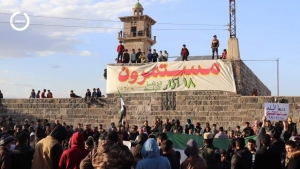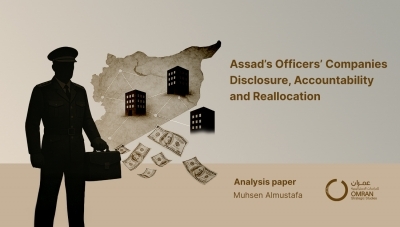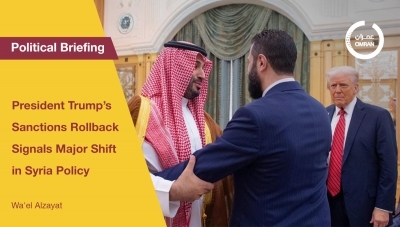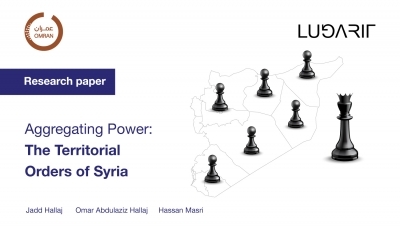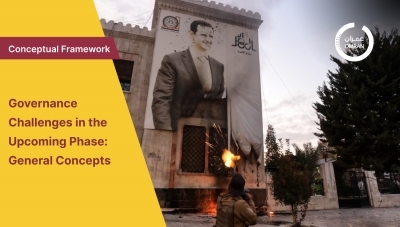Omran News
Syria's Landscape in 2023: Unrest and the False Sense of Stability
Introduction
Since the onset of the Syrian conflict, marked by a scenario of geographical entrenchment, it has witnessed a plethora of interactions and developments. These range from the structural reorganization of local actors to shifts in the global security and political landscape. The security dynamics in play challenge established boundaries and may lead to either the contraction or expansion of influence zones. Expanding parties will find opportunities to bolster their negotiating positions within the context of political settlements. The political consequences of these dynamics warrant continuous analysis and anticipation, especially considering their implications for international events, including the February earthquake and the Israeli offensive on Gaza.
This report delves into the political, security, and economic trends in Syria, highlighting the strategies of both local and international stakeholders (1).
Between International Isolation and Normalization: A Vague Arab Initiative
Throughout 2022 and 2023, efforts by Iran and Russia to facilitate the Syrian regime's re-engagement with regional countries and its re-entry onto the international stage have intensified. This includes collaboration with Turkey through a tripartite track involving Moscow, Damascus, and Ankara, which Tehran later joined, potentially extending to Arab nations. Despite enhanced security coordination, this path remains fraught with uncertainty due to conflicting interests, such as the regime's reluctance to afford electoral advantages to the Turkish president before elections and disputes over the Turkish military presence in Syria.
The thaw in relations between Arab nations and the Syrian regime has made significant strides, aligning with a regional inclination towards containing conflicts and restoring stability, albeit at the expense of comprehensive solutions. This trend is reinforced by the Arab-Turkish détente, the Saudi-Iranian rapprochement, and steps towards Arab-Israeli normalization.
The February 2023 earthquake in Turkey and Syria catalyzed a political shift that favored the regime by enabling it to solicit international aid and economic support while demanding sanctions relief. The regime's dominance over humanitarian aid delivery points, despite opposition from the United Nations and several countries, highlighted the challenges in aid distribution. This scenario also provided countries seeking normalization with the regime, driven by the “Arab Initiative,” which advocates for dialogue with Assad to achieve a comprehensive solution. This wave of Arab openness began with security and ministerial exchanges leading to the reopening of diplomatic missions in Arab capitals and culminating in Bashar al-Assad's invitation to the Jeddah summit and the restoration of Syria's Arab League membership. The “Arab Ministerial Liaison Committee,” formed under this initiative, focuses on security, counter-terrorism, and humanitarian issues, alongside advancing the political process in accordance with UN Resolution 2254. However, the impact of the Arab initiatives was limited by a lack of strategic vision and effective leverage over the Syrian regime, leading to the suspension of committee meetings due to Arab dissatisfaction with the regime's inaction. This shift towards bilateral engagements has favored the regime, enabling it to sidestep significant commitments while alleviating its isolation.
The year 2023 marked a turning point in the regime's diplomatic engagements, despite opposition from Western nations to normalization efforts. Western responses, including legal actions against Assad for war crimes, highlight the challenges of any normalization attempt, underscoring the complexities of reintegrating Syria into the global community.
A Faltering Political Process and Local Actors Trying to Establish Their Presence
The complexities of the Syrian situation are compounded by the stalled political process, with only the Constitutional Committee remaining active. Despite the stagnation of its proceedings, the committee has been in limbo since its eighth session in mid-2022, obstructing the organization of its ninth session scheduled for July 2023. Efforts by the Arab Liaison Committee to advance the political dialogue have led to the announcement of resumed sessions at the year's end, relocating from Geneva to Amman in response to Russian claims of Geneva's “lack of neutrality.” The regime's stubbornness, its indifference to the Arab initiative, and its refusal to make concessions particularly in light of the Arab rapprochement it perceives as a victory have brought the political process to a crossroads, according to Geir Pedersen.
Two sessions were conducted in the Astana format, with the twentieth potentially being the last in Kazakhstan. Kazakhstan asserts that Astana has fulfilled its aim of gradually ending Syria's regional isolation a view not shared by the trio of involved countries and instead mirrors the regime's preference for a quadripartite path excluding the opposition delegation. The concluding statement emphasized finalizing the normalization roadmap between Turkey and the regime, focusing on the northeast and de-escalation zones, opposing sanctions, broadening humanitarian aid, depoliticizing it, and acknowledging the regime's permission for its entry. This was followed by the twenty-first round on the sidelines of the UN General Assembly, which concluded without a final statement.
The regime faces escalating public unrest due to dissatisfaction with its governance, economic decline in its territories, and rampant chaos and smuggling networks. Assad's indifference was evident in a CNN interview, where he downplayed the Arab initiative's significance, asserting that political relationships are inadequate without substantial support for the Syrian state to control its borders. He insisted that linking early recovery and reconstruction efforts, and thus the returnee issue, to security and political situations is unnecessary, viewing them instead as economic necessities. His continuous emphasis on economic sanctions as a direct crisis cause, coupled with the removal of government subsidies on essential goods, has transformed public frustration into opposition movements in the Sahel, protests in Daraa, and ongoing demonstrations in Suwayda with explicit political demands backed by influential religious and social figures. The regime's attempts to quell public discontent in the Sahel involved replacing the governor, enforcing security control, or manipulating economic networks. In Suwayda, the focus was on preventing the movement's spread beyond the governorate, relying on demonstrators' fatigue and the potential for economic siege if needed. Regarding legislation and laws, the regime abolished the Military Field Court, issued decrees concerning military service, and announced a general amnesty that excludes most political prisoners. These actions are perceived as superficial, intended to appear as “reformist” steps without necessitating real guarantees.
In northwestern Syria, official opposition entities have seen their operational scope diminish due to the political process's deadlock and the regime's recognition as the sole official Syrian representative by several countries. Their activities this year were confined to opening political horizons, diplomatic endeavors following the report condemning the regime's use of chemical weapons in Douma in 2018, support tours for earthquake-affected areas, and limited efforts to curb normalization or advocate for the application of Resolution 2245, restricted to the available margins. Visits aimed at halting military escalation in Idlib were conducted, while the Sweida movement represented a significant opportunity to rejuvenate the issue, albeit not addressed adequately. Internally, opposition groups faced challenges related to their structure, elections, and the circulation of prominent figures among positions, sparking popular discontent. Additionally, the interim government's performance was weak, and the independence of these bodies' decisions was compromised by country-specific determinants.
In northeastern Syria, the Autonomous Administration's efforts were marked by pragmatism. On one hand, it sought to preemptively co-opt opposition forces in anticipation of potential Turkish normalization with the regime at their expense. It collaborated with the Syrian National Alliance Party, which established offices in its territories, and with the National Coordination Body for Democratic Change Forces to form an opposition front endorsing the “National Democratic Change Project.” This initiative, based on five fundamental principles for a successful political resolution involving “national democratic political forces” in accordance with Security Council Resolution 2254, did not alter the administration's stance. Conversely, it expressed willingness to dialogue and cooperate with the regime on its terms, with the potential integration of its forces into the Syrian army under agreeable conditions. However, according to Mazloum Abdi, the regime's rigidity obstructs this possibility. Internally, the Autonomous Administration faced protests concentrated in Deir Ezzor and spreading among Arab tribes in various “civil administrations” regions. Demonstrations were against the SDF's dominion over the area and resources, mismanagement, exclusion of the Arab component, and marginalization of its demands, represented through figures affiliated with the administration. At the Fourth Conference of the SDF, a new council was elected under co-chairmanship, considering tribal balance, represented by “Mahmoud al-Muslat,” with the presence of PYD-endorsed figures and the elimination of the “CEO” role held by Ilham Ahmed since the council's inception in 2015.
The “Democratic Autonomous Administration's social contract in the northern and eastern Syria region” was ratified, designating SDF-controlled areas as a “region” within a confederation, to be followed by general elections in 2024. The contract, more a constitution than a social agreement, was imposed by the ruling party, reflecting its views rather than local perspectives, without consultations representing societal components among local populations. Additionally, the disparity between the articles' text and their implementation, even regarding decentralization a key demand of the Autonomous Administration remains unenforced in its centrally governed areas.
The Gaza War and Its Regional Implications: Open Possibilities
Operation “Al-Aqsa Flood” presented an unexpected turn of events, causing disarray locally, regionally, and internationally. Contrary to the regional trend of containing conflicts and mitigating issues irrespective of solutions, the operation reignited concerns over the potential for war expansion, the reemergence of non-state actors, the advent of new organizations, and the ensuing humanitarian crisis requiring decisive regional responses.
In Syria, the Gaza conflict raised fears of escalation spreading to Syrian or Lebanese territories or drawing any party into participation, particularly with Iran and its affiliated militias and thus the regime considered part of the “resistance axis.” However, Iran's stance remained detached, limiting its involvement to statements, threats, and announcing support for adversarial movements such as the Houthis in Yemen and Hezbollah, which satisfied itself with ineffective missile strikes, alongside a few missiles launched from the Golan for appearances. The regime adhered to Iran's position, responding to Israeli threats with cautious, disciplined statements regarding the Palestinian cause's legitimacy, brutal aggression, and a conspiring world. It notably disregarded “Hamas,” maintaining a steadfast stance despite normalized relations, viewing it as unrepresentative of the broader issue. The regime's participation in the Riyadh summit on Gaza was confined to delivering a speech without objecting to any final statement items, including the two-state solution, civilian casualties on both sides, and establishing normal relations with Israel. Other countries, such as Tunisia, Iraq, and Algeria, expressed reservations, while Iran objected to recognizing the Palestine Liberation Organization (PLO) as the sole Palestinian representative. The regime also prevented public demonstrations condemning the war in its territories, deviating from the norm, settling for specific vigils organized by unions under Baath Party and security service supervision, possibly fearing demonstrations could turn against it.
The official opposition's response was characterized as weak, hesitant, and delayed. The coalition issued general statements of solidarity with victims and condemnation of Israeli attacks, particularly following the targeting of the Baptist Hospital, condemned by the interim government. Meanwhile, the negotiating body largely overlooked the conflict, save for a mention in a final statement from its regular Geneva session and a tweet by the body's head. This cautious approach is attributed to apprehension over potential backlash and the loss of Western support the last remaining political backing for the Syrian cause additionally influenced by Hamas's stance, which had recently reestablished relations with the regime. The position of Hay'at Tahrir al-Sham (HTS) was more pronounced at the official level, issuing statements supporting the Palestinian cause without mentioning Hamas, alongside official events and fundraising through endowments. Opposition-controlled areas in northern Aleppo and Idlib witnessed significant public demonstrations in support of the Palestinian cause.
The SDF did not articulate an official stance on the conflict, except for a neutral statement by former SDF executive Ilham Ahmed, expressing solidarity with victims on both sides without taking a definitive stand on the aggression. This was despite the historically pro-Palestinian stance of Kurdish organizations, attributed to concerns over the American ally's position, Hamas's proximity to Turkey, and reluctance to express opinions unrelated to the consolidation of the self-administration project.
The Regime’s Systemic and Functional Security Crises
With the escalation of the Gaza conflict into a pivotal international juncture, its repercussions resonated deeply within the Syrian landscape, primarily serving as a conduit for message exchanges and score-settling between Israel and Iran. Meanwhile, the Syrian regime maintained a cautious distance from the conflict amidst Israeli cautions to Iran about the repercussions of its involvement. In this backdrop, international coalition bases faced recurrent assaults, paralleling a series of attacks by Iranian proxies in the region against US and Israeli interests from Lebanon, Yemen, Iraq, and Syria, including selective strikes targeting southern Syria near the Golan Heights. Concurrently, Israel ramped up its attacks on the infrastructure and command echelons of regime forces and Iranian militias, notably executing the assassination of Reza Mousavi, a leading Iranian official in Syria. This move was part of Israel's strategy to weaken the efforts of Iranian militias to fortify their positions following the assault on Gaza, showcasing their military prowess and readiness across multiple fronts.
Domestically, the Syrian regime's security infrastructure grappled with multiple challenges, including bombings and assassinations in supposedly secure regions, such as the Homs and Damascus countryside. A significant incident was a drone attack on a military academy, claiming the lives of 123 regime personnel, including several brigadier generals. This event highlighted substantial security lapses, challenging the regime's security framework and the air supremacy claimed by Russia and the regime west of the Euphrates, as well as contesting the aerial dominance of regional powers amid the advancing military capabilities of non-state actors utilizing drones in Syria and the wider region.
Within territories under regime control, As-Suwayda governorate witnessed an insurrection and popular movement, posing a severe challenge to the regime's narrative of stability and control. The movement in Suwayda, carrying both national and local dimensions, underscored the governorate's strategic significance owing to its proximity to al-Tanf and its role as a conduit for smuggling operations. The regime's strategy to counter this movement involved demonizing it in the media as separatist or foreign-driven, aiming to isolate it on a national level. Moreover, the regime leveraged the strategy of time, withholding services and exacerbating the already dire living conditions to pressure the movement, while attempting to fragment it by exploiting differences among religious and social factions within Suwayda. Despite the movement's impact being confined primarily to Suwayda, its importance lies in challenging the regime's narrative centered on “minority protection,” emphasizing Suwayda's strategic significance in security discussions, particularly regarding smuggling and its proximity to critical security locales.
The ISIS threat persists despite the assassination of its fourth leader by Turkish intelligence, as the organization continues to pose a security risk in Syria and globally. This is manifested by an escalation in the number and quality of operations it conducts, especially in the last quarter of the past year, leading to a marked Russian air escalation, representing a significant counteraction against the organization in 2023. While Jordan has revised its rules of engagement in response to the escalating threat from drug and arms smuggling networks supported by the regime and Iran along its northern border. This adjustment reflects Jordan's growing concerns over the sheer number of these groups, their technological and military capabilities, and the ineffectiveness of Jordanian dialogue with the regime in securing tangible security outcomes. Jordan, since May, has resorted to force, conducting air raids within Syrian territory, and requested Patriot missile systems from the United States to counter the drone threat.
Beyond the Regime's Control: Attempts at Governance and Resistance
In areas under the Autonomous Administration in northeastern Syria, the Syrian Democratic Forces (SDF) encountered several challenges, notably a tribal uprising following the detention of Abu Khawla, the leader of the Deir Ezzor Military Council. This uprising reflects deep-seated structural problems within the SDF's capacity to assimilate the Arab component and redress tribal grievances due to the dominance of the Workers' Party within the SDF's administration. The absence of American initiative to induce changes within the SDF, along with internal tribal challenges and apprehensions regarding potential encroachment by Iranian militias, collectively shape the future prospects of the tribal movement in the region. Turkey has maintained its aggressive posture towards the PKK, designated as a terrorist organization, especially following an incident in Ankara in October. This prompted Turkey to intensify its aerial bombardments targeting SDF military leadership and infrastructure, highlighting Turkey's strategic reach and its reliance on sophisticated drone technology in its counterterrorism strategy.
In northwestern Syria, Hay'at Tahrir al-Sham (HTS) has launched an unparalleled campaign of internal arrests, detaining members from its administrative, security, and media wings on charges of espionage for the regime, Russia, or the United States. This move signifies HTS leadership's ongoing efforts to consolidate control and neutralize prominent figures, while also capitalizing on factionalism within areas controlled by the National Army to expand its influence.
The Regime's Economic Policies: Burdening Society and State
In January 2023, the Syrian regime initiated a series of bold economic reforms, characterized by a significant reduction in social support mechanisms, placing an increased burden on the market and exacerbating the poverty and living crisis of its citizens. The commencement of 2023 saw the average cost of living in Syria surge to over 4 million SYP for a family of five, with the number of individuals in need of humanitarian assistance soaring to more than 15 million at the start of the year. The devaluation of the Syrian pound continued, with the exchange rate exceeding 7,500 SYP to the dollar by the end of the previous year and recorded at 6,825 SYP by the end of January 2023. The regime's government increased the price of gasoline, marking the second hike within three weeks amid a significant scarcity of petroleum derivatives. Additionally, the Ministry of Economy raised customs duties on all imports by 15-20%, contributing to increased prices for imported goods.
These trends persisted and even escalated in the following months, with the average living costs for a family of five in Syria reaching more than 10.3 million SYP by August, according to the “Qasioun Newspaper” index, up from 4 million SYP in January. Despite salary increases, the average wages, post-increase, did not surpass 200,000 SYP. The regime's economic policies led to a continuous decline in the value of the Syrian pound, surpassing 15,000 SYP against the dollar, with the central bank pricing the exchange rate for remittances at 10,900 pounds. This ongoing devaluation significantly reduced the citizens' purchasing power, rendering salary increases ineffective and exacerbating the population's poverty and living hardships. These developments also underscore the ineffectiveness of the regime's economic management, which addresses the crisis with unproductive solutions.
A significant and economically indicative trend was the increased rate of merchant emigration, especially among traders from Aleppo and Damascus. This included the relocation of significant gold reserves, estimated at around 300 kilograms (approximately 1% of the country's total gold reserves), by top jewelers including (Bashoura, Said Mansour, and al-Jazmati), who moved their entire stock abroad.
Regarding trade relations between the regime and Arab countries, the regime showed considerable interest in economic openness towards Iraq and Saudi Arabia. The Syrian regime appointed an ambassador to the Arab League and conducted visits to Iraq and Saudi Arabia, agreeing to resume economic cooperation with Arab states. Iraq allowed Syrian trucks to enter its territory again at the beginning of the year following agreements between the Syrian Ministry of Transport and the Iraqi side, leading to a 35% increase in trade between Syria and Iraq. Moreover, Jordanian exports through the Nassib crossing in the previous year, 2022, were 23 times the Syrian exports, which only amounted to $20 million.
On the other hand, the regime allowed merchants to import from Saudi Arabia, signing a contract for sugar imports and working on mechanisms to facilitate the movement of Syrian and Saudi trucks in the coming period. The regime stated that there is “no political objection” to importing goods from Saudi Arabia, permitting the import of sugar, chemicals, and petrochemicals. After a hiatus in investments in Syria since 2011, the regime granted licenses in August to two companies owned by Saudi investors to invest in the phosphate, fertilizer, and cement sectors in Syria. The regime's exports of vegetables and fruits amounted to between 500 to 600 tons, with 90% directed to Saudi Arabia, amid almost daily price hikes in the local market due to production shortages and rising costs of raw materials, including fuel, seeds, transportation, and labor. After potato prices surged by 150% in local markets, the Ministry of Economy halted its export when the price per kilogram reached 5,000 SYP, up from 2,000 SYP per kilogram in August, despite the regime's prior approval to export 40,000 tons of potatoes.
In regard to Iran economic activities in 2023, it didn’t spare no effort in 2023 to increase its influence and consolidate its presence in the Syrian economy, with the Iranian Minister of Roads and Urban Development Mehrdad Bazrpash signing agreements with the Syrian regime during an April visit in various sectors including economy, trade, housing, oil, industry, electricity, transport, and insurance. In addition to scheduled plans for stablishing an oil refinery with a capacity of 140,000 barrels per day, adjacent to the existing refineries in Homs and Baniyas, as announced by the Iranian Oil Minister Jalil Salari, to augment the income of Iranian companies. This plan is alongside numerous others set by Iran in Syria over the past years, though sanctions on the Syrian and Iranian oil sectors stand as barriers to maintaining and implementing oil projects in Syria that could fund the regime.
During a visit by the Governor of the Central Bank of Iran, Mohammad Reza Farzin, to Damascus, both sides agreed on a mechanism for using local currencies in trade exchanges between the two countries and establishing communication channels between the central banks to evade sanctions. In the context of bolstering banking and trade relations and joint investments, the Iranian official mentioned Iran's intention to soon open its first bank in Syria.
In December, a Syrian regime delegation in Tehran, led by Prime Minister Hussein Arnous, signed memorandums of understanding in banking, finance, tourism, sports, culture, reconstruction, trade, and the operation of power plants in Syria by Iranian investors. They agreed on zeroing customs duties between the two countries, and the Syrian Central Bank governor discussed with his Iranian counterpart ways to develop trade relations, establish mechanisms for trade exchange in local currencies, and set up a joint bank in Syria. This also includes executing a series of projects by the “Bonyad Mostazafan” foundation, Iran's second-largest investment entity, encompassing 200 factories and financial companies, including a bank and real estate companies, which is internationally sanctioned and directly affiliated with the Iranian Supreme Leader Ali Khamenei. This step aims to fulfill Tehran's goal of acquiring a broader share in the Syrian economy.
Aftermath of the February Earthquake: An Alarming Economic Scene
February 2023 witnessed a devastating earthquake that struck northern Syria and southern Turkey on February 6th, affecting over 1.8 million people in northwestern Syria. The catastrophe resulted in the loss of 4,256 civilians' lives, approximately 12,000 injuries, and displaced 300,000 individuals, with children, women, and special needs cases constituting more than 65% of the displaced. The economic losses amounted to $1.95 billion, affecting the public and private sectors and other facilities, while over 13,000 families lost their income sources. The earthquake damaged infrastructure, including 433 schools, 73 medical facilities, and 136 housing units, with over 2,000 buildings collapsing immediately.
The Assad regime saw the earthquake disaster as a lifeline to boost economic activity within its control zones, launching donation campaigns and “for earthquake victims” and receiving financial donations from industrialists in Homs and businessmen estimated at 1.5 billion SYP. Additionally, pro-regime parties and groups exploited the earthquake to campaign for the flow of aid to the Syrian regime and lifting sanctions imposed on it due to crimes committed over the past decade, which restricted its economic activities. The Cross-Border Humanitarian Fund for Syria announced the release of at least $50 million for humanitarian response following the disaster, and the Omran Center for Strategic Studies reported that 23 countries and the United Nations sent approximately 11,772 tons of humanitarian and logistical aid through regime-controlled airports in Damascus, Aleppo, and Latakia. The regime received about 435 trucks of aid from several Arab countries through the Arbaeen, Jadidah, Nassib, and al-Bukamal crossings.
In opposition-held areas in the countryside of Aleppo and Idlib, the region significantly suffered from a lack of aid in the first week of the disaster. The Omran Center for Strategic Studies reported that around 590 trucks, carrying between 5,300 and 7,000 tons of aid, entered from the Bab al-Hawa, al-Salam, and al-Raee crossings between February 9 and 27.
In northeastern Syria, the Autonomous Administration attempted to exploit the earthquake's aftermath to make a breakthrough in its relationship with the opposition by offering a convoy of fuel and medical supplies to the affected areas, which the opposition rejected for reasons including the Administration's insistence on branding the aid with its logos. The Administration announced the opening of all its crossings for humanitarian aid coming from outside its control areas to reach the earthquake victims. In the context of civil and popular initiatives, several civil organizations and social activities in northeastern Syria launched public campaigns to collect financial and in-kind donations from the region's residents and send them to the victims in the affected areas, including the “Tribal Solidarity” campaign, which collected 146 trucks loaded with clothing, household furnishings, food, baby milk, and medical supplies, along with financial donations, and entered the affected areas in northwestern Syria. However, the region later saw a clear decline in humanitarian response operations for the earthquake victims by 35% compared to the end of February, leaving thousands of families unable to secure even one meal a day amidst rising poverty rates and decreasing purchasing power among the population.
Methods of addressing economic impacts varied across influence zones, including periodic salary increases for employees, decisions to regulate markets, and increased control by de facto authorities over economic life. In terms of economic governance, the Autonomous Administration issued two laws to regulate exchange and remittance businesses and the trade and manufacturing of precious metals. The Administration also prohibited the export of dollars from its areas to those controlled by the regime and the opposition, as part of measures to restrict money transfers in and out of its areas, indicating increased financial or cash outflows abroad through smuggling operations, the rise of illegal activities, money laundering, tax evasion, and the Administration's preventive stance towards the available foreign currency reserves.
The Salvation Government in Idlib established a commercial court headquartered in Sarmada city, aimed at addressing disputes and cases arising between traders registered with the chambers of commerce. The court operates in 8 specializations, including intellectual property, bankruptcy, and disputes related to commercial papers, exchange, currencies, commercial remittances, and banking activities. This court's establishment follows a series of decisions, including one to regulate contracting procedures, contributing to the institutionalization and governance of the economy in the region, especially given the multitude of commercial activities and complex trade relations with the existence of the Bab al-Hawa crossing linking Idlib to Turkey. The Salvation Government's efforts aim to attract investors to its controlled areas. While the Interim Government also focused on encouraging investments in its controlled areas, with the Ministry of Finance and Economy announcing the launch of the first Investment Conference in cooperation with Aleppo University in the liberated areas, the Economists Syndicate, and the 2020IDEA foundation. The conference aims to economically develop the liberated areas, improve living standards, increase job opportunities, and resume the entry of UN aid into northwestern Syria through the Bab al-Hawa border crossing with Turkey.
Conclusion
In conclusion, the Syrian scene remains largely static, with no significant changes expected from international actors or de facto authorities. Despite the regime's political breakthrough following regional normalization and partial restoration of international legitimacy, significant challenges persist, including maintaining influence, navigating ongoing negotiations without concessions, and addressing deteriorating living conditions that could lead to potential unrest. The dynamic security landscape, further complicated by the Gaza war's implications, highlights the intricate interplay between regional actors, local dynamics, and the enduring threats to national security for countries like Turkey and Jordan. This complex scenario emphasizes the evolving nature of the conflict, strategic shifts among local actors, and the continuous need for adaptation to both internal and external pressures.
([1]) For access to the Omran Center's monthly briefings during 2023, see the following link: https://bit.ly/3VXM9hi

